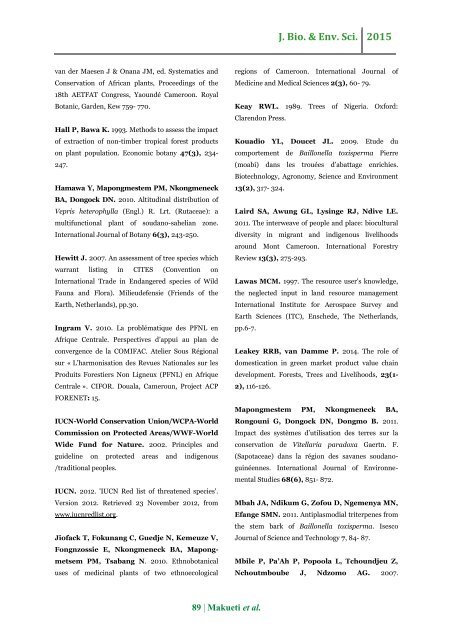Local communities’ perception and willingness on sustainable management of a natural threatened resource: case study of Baillonella toxisperma Pierre in Eastern Cameroon - JBES
Baillonella toxisperma is a multipurpose tree that provides non-timber forest products. In particular, fruit kernels can be transformed into buffer for cooking and cosmetics and its bark is used to cure many ailments in local communities. Unfortunately, natural stands of B. toxisperma are seriously threatened in Cameroon. The objectives of the study were to document uses of the targeted species, its management patterns and assess its population structure. Ethnobotanical and quantitative ecological methods were used. The results showed that the species was found to be multipurpose and produced several products and services. The most mentioned services were conservation of foodstuffs and medicine. Community responses indicated that the species became rare and there were no strategies developed to preserve it. The quantitative inventory supported this community view: the species had a low density (0.02 individual/ha) and a weak size class distribution. The species appeared to be threatened by illegal logging, overexploitation and poor attitude to its conservation. Due to the high value of the species, respondents claimed that they were interested in conserving it but they lacked appropriate propagation techniques, materials and skills. Thus, the sensitization and the domestication of the species should urgently be considered in the farmer environment with strong sound of policy. Source of original Articles: http://www.innspub.net/volume-6-number-5-may-2015-jbes/
Baillonella toxisperma is a multipurpose tree that provides non-timber forest products. In particular, fruit kernels can be transformed into buffer for cooking and cosmetics and its bark is used to cure many ailments in local communities. Unfortunately, natural stands of B. toxisperma are seriously threatened in Cameroon. The objectives of the study were to document uses of the targeted species, its management patterns and assess its population structure. Ethnobotanical and quantitative ecological methods were used. The results showed that the species was found to be multipurpose and produced several products and services. The most mentioned services were conservation of foodstuffs and medicine. Community responses indicated that the species became rare and there were no strategies developed to preserve it. The quantitative inventory supported this community view: the species had a low density (0.02 individual/ha) and a weak size class distribution. The species appeared to be threatened by illegal logging, overexploitation and poor attitude to its conservation. Due to the high value of the species, respondents claimed that they were interested in conserving it but they lacked appropriate propagation techniques, materials and skills. Thus, the sensitization and the domestication of the species should urgently be considered in the farmer environment with strong sound of policy. Source of original Articles: http://www.innspub.net/volume-6-number-5-may-2015-jbes/
Create successful ePaper yourself
Turn your PDF publications into a flip-book with our unique Google optimized e-Paper software.
J. Bio. & Env. Sci. 2015<br />
van der Maesen J & Onana JM, ed. Systematics <str<strong>on</strong>g>and</str<strong>on</strong>g><br />
C<strong>on</strong>servati<strong>on</strong> <strong>of</strong> African plants, Proceed<strong>in</strong>gs <strong>of</strong> the<br />
18th AETFAT C<strong>on</strong>gress, Yaoundé Camero<strong>on</strong>. Royal<br />
Botanic, Garden, Kew 759- 770.<br />
Hall P, Bawa K. 1993. Methods to assess the impact<br />
<strong>of</strong> extracti<strong>on</strong> <strong>of</strong> n<strong>on</strong>-timber tropical forest products<br />
<strong>on</strong> plant populati<strong>on</strong>. Ec<strong>on</strong>omic botany 47(3), 234-<br />
247.<br />
Hamawa Y, Map<strong>on</strong>gmestem PM, Nk<strong>on</strong>gmeneck<br />
BA, D<strong>on</strong>gock DN. 2010. Altitud<strong>in</strong>al distributi<strong>on</strong> <strong>of</strong><br />
Vepris heterophylla (Engl.) R. Lrt. (Rutaceae): a<br />
multifuncti<strong>on</strong>al plant <strong>of</strong> soudano-sahelian z<strong>on</strong>e.<br />
Internati<strong>on</strong>al Journal <strong>of</strong> Botany 6(3), 243-250.<br />
Hewitt J. 2007. An assessment <strong>of</strong> tree species which<br />
warrant list<strong>in</strong>g <strong>in</strong> CITES (C<strong>on</strong>venti<strong>on</strong> <strong>on</strong><br />
Internati<strong>on</strong>al Trade <strong>in</strong> Endangered species <strong>of</strong> Wild<br />
Fauna <str<strong>on</strong>g>and</str<strong>on</strong>g> Flora). Milieudefensie (Friends <strong>of</strong> the<br />
Earth, Netherl<str<strong>on</strong>g>and</str<strong>on</strong>g>s), pp.30.<br />
Ingram V. 2010. La problématique des PFNL en<br />
Afrique Centrale. Perspectives d‟appui au plan de<br />
c<strong>on</strong>vergence de la COMIFAC. Atelier Sous Régi<strong>on</strong>al<br />
sur « L‟harm<strong>on</strong>isati<strong>on</strong> des Revues Nati<strong>on</strong>ales sur les<br />
Produits Forestiers N<strong>on</strong> Ligneux (PFNL) en Afrique<br />
Centrale ». CIFOR. Douala, Cameroun, Project ACP<br />
FORENET: 15.<br />
IUCN-World C<strong>on</strong>servati<strong>on</strong> Uni<strong>on</strong>/WCPA-World<br />
Commissi<strong>on</strong> <strong>on</strong> Protected Areas/WWF-World<br />
Wide Fund for Nature. 2002. Pr<strong>in</strong>ciples <str<strong>on</strong>g>and</str<strong>on</strong>g><br />
guidel<strong>in</strong>e <strong>on</strong> protected areas <str<strong>on</strong>g>and</str<strong>on</strong>g> <strong>in</strong>digenous<br />
/traditi<strong>on</strong>al peoples.<br />
IUCN. 2012. 'IUCN Red list <strong>of</strong> <strong>threatened</strong> species'.<br />
Versi<strong>on</strong> 2012. Retrieved 23 November 2012, from<br />
www.iucnredlist.org.<br />
Ji<strong>of</strong>ack T, Fokunang C, Guedje N, Kemeuze V,<br />
F<strong>on</strong>gnzossie E, Nk<strong>on</strong>gmeneck BA, Map<strong>on</strong>gmetsem<br />
PM, Tsabang N. 2010. Ethnobotanical<br />
uses <strong>of</strong> medic<strong>in</strong>al plants <strong>of</strong> two ethnoecological<br />
regi<strong>on</strong>s <strong>of</strong> Camero<strong>on</strong>. Internati<strong>on</strong>al Journal <strong>of</strong><br />
Medic<strong>in</strong>e <str<strong>on</strong>g>and</str<strong>on</strong>g> Medical Sciences 2(3), 60- 79.<br />
Keay RWL. 1989. Trees <strong>of</strong> Nigeria. Oxford:<br />
Clarend<strong>on</strong> Press.<br />
Kouadio YL, Doucet JL. 2009. Etude du<br />
comportement de Baill<strong>on</strong>ella <strong>toxisperma</strong> <strong>Pierre</strong><br />
(moabi) dans les trouées d‟abattage enrichies.<br />
Biotechnology, Agr<strong>on</strong>omy, Science <str<strong>on</strong>g>and</str<strong>on</strong>g> Envir<strong>on</strong>ment<br />
13(2), 317- 324.<br />
Laird SA, Awung GL, Lys<strong>in</strong>ge RJ, Ndive LE.<br />
2011. The <strong>in</strong>terweave <strong>of</strong> people <str<strong>on</strong>g>and</str<strong>on</strong>g> place: biocultural<br />
diversity <strong>in</strong> migrant <str<strong>on</strong>g>and</str<strong>on</strong>g> <strong>in</strong>digenous livelihoods<br />
around M<strong>on</strong>t Camero<strong>on</strong>. Internati<strong>on</strong>al Forestry<br />
Review 13(3), 275-293.<br />
Lawas MCM. 1997. The <strong>resource</strong> user's knowledge,<br />
the neglected <strong>in</strong>put <strong>in</strong> l<str<strong>on</strong>g>and</str<strong>on</strong>g> <strong>resource</strong> <strong>management</strong><br />
Internati<strong>on</strong>al Institute for Aerospace Survey <str<strong>on</strong>g>and</str<strong>on</strong>g><br />
Earth Sciences (ITC), Enschede, The Netherl<str<strong>on</strong>g>and</str<strong>on</strong>g>s,<br />
pp.6-7.<br />
Leakey RRB, van Damme P. 2014. The role <strong>of</strong><br />
domesticati<strong>on</strong> <strong>in</strong> green market product value cha<strong>in</strong><br />
development. Forests, Trees <str<strong>on</strong>g>and</str<strong>on</strong>g> Livelihoods, 23(1-<br />
2), 116-126.<br />
Map<strong>on</strong>gmestem PM, Nk<strong>on</strong>gmeneck BA,<br />
R<strong>on</strong>gouni G, D<strong>on</strong>gock DN, D<strong>on</strong>gmo B. 2011.<br />
Impact des systèmes d‟utilisati<strong>on</strong> des terres sur la<br />
c<strong>on</strong>servati<strong>on</strong> de Vitellaria paradoxa Gaertn. F.<br />
(Sapotaceae) dans la régi<strong>on</strong> des savanes soudanogu<strong>in</strong>éennes.<br />
Internati<strong>on</strong>al Journal <strong>of</strong> Envir<strong>on</strong>nemental<br />
Studies 68(6), 851- 872.<br />
Mbah JA, Ndikum G, Z<strong>of</strong>ou D, Ngemenya MN,<br />
Efange SMN. 2011. Antiplasmodial triterpenes from<br />
the stem bark <strong>of</strong> Baill<strong>on</strong>ella <strong>toxisperma</strong>. Isesco<br />
Journal <strong>of</strong> Science <str<strong>on</strong>g>and</str<strong>on</strong>g> Technology 7, 84- 87.<br />
Mbile P, Pa’Ah P, Popoola L, Tchoundjeu Z,<br />
Nchoutmboube J, Ndzomo AG. 2007.<br />
89 | Makueti et al.


















